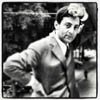 Aldo Rossi Aldo Rossi Aldo Rossi (1931-1997), Italy Aldo Rossi (1931-1997), the architect known as much for his theory, drawing, architecture and product design was one of Italy's leading figures in modern design and architecture during the 20th century. Rossi was born in Milan, Italy where his father was engaged in the manufacture of bicycles, bearing the family name, a business he says was founded by his grandfather. While growing up during the years of World War II, Rossi's early education took place at Lake Como, and later in Lecco. Shortly after the war ended, he entered the Milan Polytechnic University, receiving his architecture degree in 1959. Rossi served as editor of the Architectural magazine Casabella from 1955 to 1964. The Italian star architect and designer Aldo Rossi is one of the big names in Postmodernism. While studying architecture from 1949 until 1959 at Milan Polytechnic, Aldo Rossi was already writing for the architecture journal "Casabella Continuità"; from 1960 until 1964 he was editor of it. Aldo Rossi also wrote for the journal "Il Contemporaneo". In the 1960s Aldo Rossi embarked on his first building projects, which even then were notable for the reduced, clear formal language that would remain Aldo Rossi's hallmark. In 1966 a book of Aldo Rossi's was published to international acclaim: "L'architettura della città" (Urban Architecture). In 1965 Aldo Rossi Dozent began to teach at Milan Polytechnic, became a professor there in 1966, and continued to teach there until 1971. From 1972 until 1975 Aldo Rossi taught at the ETH in Zurich. In 1964 Aldo Rossi and Luca Meda co-organized the 13th Milan Triennale. In 1973 Aldo Rossi organized the 15th Triennale, where he made a controversial attempt at rehabilitating the rationalist architecture once favored by the Fascists. Aldo Rossi wanted to detach its formal language, materials, and structural approach from its tainted historical context and make them available to Postmodernism. Aldo Rossi's most important architectural achievements include the Gallaterese residential settlement in Milan (1968-73) and the "Teatro del Mondo" in Venice (1979). In 1988 Aldo Rossi won the competition for designing the building of the History Museum in Berlin, which, however, has not been built. Between 1992 and 1995 Aldo Rossi built the Bonnefanten Museum in Maastricht. In 1997 he planned several buildings for Leipziger Platz in Berlin, not all of which, however, have been built. In 1985 Aldo Rossi was head of the 3rd Architecture Biennale in Venice. As a designer, Aldo Rossi created numerous objects for Alessik including appliances such as the "La Conica" (1984) and "La Cupola" (1989) espresso machines. In 1988 Aldo Rossi 1988 designed the "Prometeo" table lamp, also for Alessi. He also designed the elegant, beautifully shaped "Milano" chair, that was made in both cherry and oak (1988). Another Aldo Rossi chair is the 1989 "Parigi", an armchair whose stringent geometry is softened by its backward inclination. In 1990 Aldo Rossi became the first Italian to be awarded the prestigious Pritzker Prize for architecture. |

